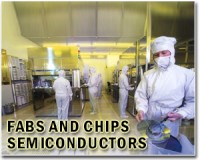 |
Washington DC (SPX) Jan 21, 2011 In the materials science equivalent of a football fan jumping onto the field and scoring a touchdown, scientists are documenting that one fundamental component of computer chips, long regarded as a passive bystander, can actually be made to act like a switch. That potentially allows it to take part in the electronic processes that power cell phones, iPads, computers, and thousands of other products. In a report in the Journal of the American Chemical Society, the scientists document the multiple ways in which silicon dioxide, long regarded simply as an electric insulator, gets involved in the action. This behavior had formerly confused scientists working in the area of nanoelectronics - they thought that the switching was due to the nano-additive but it turns out that the source of the switching might be from the underlying silicon oxide itself. Jun Yao, Douglas Natelson, Lin Zhong, and James Tour explain that manufacturers have long used silicon oxide, normally a very poor conductor of electricity, as both a supportive and insulating material in electronics. Silicon, a primary component of beach sand, is the semiconductor material at the heart of modern electronics. When bound to oxygen, the resulting silicon oxide is generally one of the highest quality electronic insulating materials. The scientists recently showed, however, that the oxide material can be converted to a switchable conductor by an electrical process. This phenomenon may hold the key to developing a new generation of smaller, more powerful computer chips, but the mechanism behind this switching was unclear, until now. It also clarifies the possible nature behind the switching events in former molecular and nano-scale systems. The scientists sandwiched a nano-sized layer of silicon oxide, thousands of times smaller than the width of a human hair, between two electrodes and exposed the device to increasing amounts of electrical current. They demonstrated that electricity can cause the silicon oxide to breakdown into smaller components, nano-sized crystals of silicon, in a way that boosts its electrical conductivity and makes it a player in the working processes of computer chips.
Share This Article With Planet Earth
Related Links American Chemical Society Computer Chip Architecture, Technology and Manufacture Nano Technology News From SpaceMart.com
 Intel earnings soar with rise of "cloud" computing
Intel earnings soar with rise of "cloud" computingSan Francisco (AFP) Jan 13, 2011 US computer chip giant Intel on Thursday posted its best earnings ever in 2010 as businesses beefed up data centers to handle services increasingly shifting to the Internet "cloud." Intel said it took in a net profit of $11.7 billion for the year on revenue of $43.6 billion, a 167 percent jump from the profit it posted in 2009. "2010 was the best year in Intel's history," the California- ... read more |
|
| The content herein, unless otherwise known to be public domain, are Copyright 1995-2010 - SpaceDaily. AFP and UPI Wire Stories are copyright Agence France-Presse and United Press International. ESA Portal Reports are copyright European Space Agency. All NASA sourced material is public domain. Additional copyrights may apply in whole or part to other bona fide parties. Advertising does not imply endorsement,agreement or approval of any opinions, statements or information provided by SpaceDaily on any Web page published or hosted by SpaceDaily. Privacy Statement |